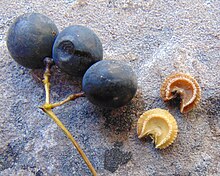
Ranunculales is an order of flowering plants. Of necessity it contains the family Ranunculaceae, the buttercup family, because the name of the order is based on the name of a genus in that family. Ranunculales belongs to a paraphyletic group known as the basal eudicots. It is the most basal clade in this group; in other words, it is sister to the remaining eudicots. Widely known members include poppies, barberries, hellebores, and buttercups.

Ranunculaceae is a family of over 2,000 known species of flowering plants in 43 genera, distributed worldwide.

Menispermum (moonseed) is a small genus of deciduous climbing woody vines in the moonseed family (Menispermaceae). Plants in this genus have small dioecious flowers, and clusters of small grape-like drupes. The name, moonseed, comes from the shape of the seed, which resembles a crescent moon. The word Menispermum is derived from the Greek words μήν (mēn), meaning (crescent) moon, and σπέρμα (sperma) meaning seed. The common name moonseed is also applied to some other species in the related genus Cocculus.

The Papaveraceae are an economically important family of about 42 genera and approximately 775 known species of flowering plants in the order Ranunculales, informally known as the poppy family. The family is cosmopolitan, occurring in temperate and subtropical climates like Eastern Asia as well as California in North America. It is almost unknown in the tropics. Most are herbaceous plants, but a few are shrubs and small trees. The family currently includes two groups that have been considered to be separate families: Fumariaceae and Pteridophyllaceae. Papaver is the classical name for poppy in Latin.

Curare is a common name for various alkaloid arrow poisons originating from plant extracts. Used as a paralyzing agent by indigenous peoples in Central and South America for hunting and for therapeutic purposes, curare only becomes active when it contaminates a wound or is introduced directly to the bloodstream; it is not active when ingested orally. These poisons cause weakness of the skeletal muscles and, when administered in a sufficient dose, eventual death by asphyxiation due to paralysis of the diaphragm. Curare is prepared by boiling the bark of one of the dozens of plant sources, leaving a dark, heavy paste that can be applied to arrow or dart heads. In medicine, curare has been used as a treatment for tetanus and strychnine poisoning and as a paralyzing agent for surgical procedures.

Anamirta is a genus of woody vines in the family of Menispermaceae, native to southern Asia. It has a single extant species, which is Anamirta cocculus.

Cocculus is a genus of four species of woody vines and shrubs, native to tropical and subtropical regions of Africa and Asia.

Tubocurarine is a toxic benzylisoquinoline alkaloid historically known for its use as an arrow poison. In the mid-1900s, it was used in conjunction with an anesthetic to provide skeletal muscle relaxation during surgery or mechanical ventilation. Safer alternatives, such as cisatracurium and rocuronium, have largely replaced it as an adjunct for clinical anesthesia and it is now rarely used.

Anomospermum is a genus of flowering plants in the family Menispermaceae. It consists of five species from tropical America, ranging from Nicaragua to southern Brazil.

Anamirta cocculus is a Southeast Asian and Indian climbing plant. Its fruit is the source of picrotoxin, a poisonous compound with stimulant properties.

Abuta is a genus in the flowering plant family Menispermaceae, of about 32 species, native to tropical Central and South America.

Stephania is a genus of flowering plants in the family Menispermaceae, native to eastern and southern Asia and Australia. They are herbaceous perennial vines, growing to around four metres tall, with a large tuber. The leaves are arranged spirally on the stem and are peltate, with the leaf petiole attached near the centre of the leaf. The name Stephania comes from the Greek, "a crown". This refers to the anthers being arranged in a crown-like manner.
Curarea candicans is a species of flowering plant in the family Menispermaceae.

Cissampelos is a genus of flowering plants in the family Menispermaceae. Various species of this genus have a history of use in various traditions of herbal medicine. Moreover, many of these plants were used as curare applied as arrow poison during hunting.

Chondrodendron tomentosum is one of six accepted species in the small genus Chondrodendron, belonging to the Moonseed family Menispermaceae. It is a large tropical liana native to Central and South America. It contains highly toxic alkaloids and is one of the sources of the arrow poison curare – specifically 'tube curare', the name of which is derived from the name of the medicinally valuable alkaloid tubocurarine.
Abuta aristeguietae is a species within the Abuta genus, a constituent of the Menispermaceae family.
Abuta dwyeriana is a species of the Abuta genus, which is part of the flowering plant family Menispermaceae.
Abuta pahnii is a species of the Abuta genus, which is part of the flowering plant family Menispermaceae. This genus consists of about 32 species, native to tropical Central and South America.
Abuta fluminum is a species of flowering plant in the family Menispermaceae.


























